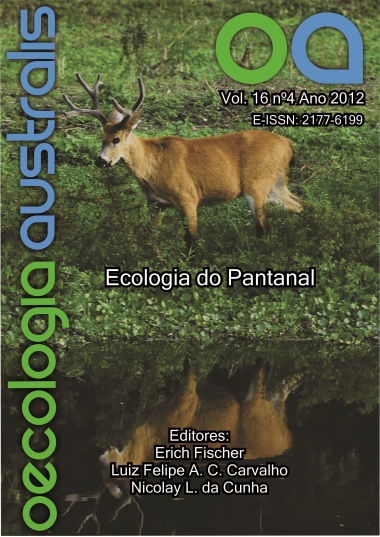LIFE HISTORY TRAITS OF ODONTOSTILBE PEQUIRA (STEINDACHNER, 1882) IN THE PANTANAL OF PORTO MURTINHO, MATO GROSSO DO SUL STATE, BRAZIL
Palavras-chave:
intraspecific variation, population biology, cheirodontinae, growth rate, recruitmentResumo
This study aimed to analyze the life history traits of females and males of Odontostilbe pequira, and correlate the recruitment of both sexes with the variation in the flood pulse of Paraguay River. The samplings were performed every month between February 2009 to January 2011, along the main channel of Paraguay River and its tributary (Amonguijá River) and the marginal lakes Criminosa and Flores. Length data were taken from 977 individuals of Odontostilbe pequira (564 females and 413 males). The equation that describes the relationship weight/length for females is Total weight=0.0000183*Standard length 2.95, and for males, Total weight=0.0000105*Standard length 3.10 , with isometric growth for females and positive allometric for males. The asymptotic length (L?) estimated for females was greater (39.59mm) than for males (37.57mm). Females also had higher growth rate (k=0.93 year-1, Rn=0.35) and natural mortality rate (Z=1.56 year-1 ) than males (k=0.82 year-1, Rn= 0.27, Z= 1.45 year-1). Through the growth curves, generated by the distribution of length classes, it was registered 3 complete cohorts for females, with longevity estimated at 3.22 years, and 4 cohorts for males with longevity of 3.65 years. The growth performance index values (?) were close to 3 and similar between females (?= 3.16) and males (?= 3.06). The recruitment pattern was long for females and males of O. pequira, without significant variation in the recruitment distribution (p=0.77) between sexes. The recruitment peak occurred in July and June, for females and males, respectively. There was correlation between the recruitment and the water level of the river for both sexes (females: r=0.91, p<0.001, males: r=0.67, p=0.02).


